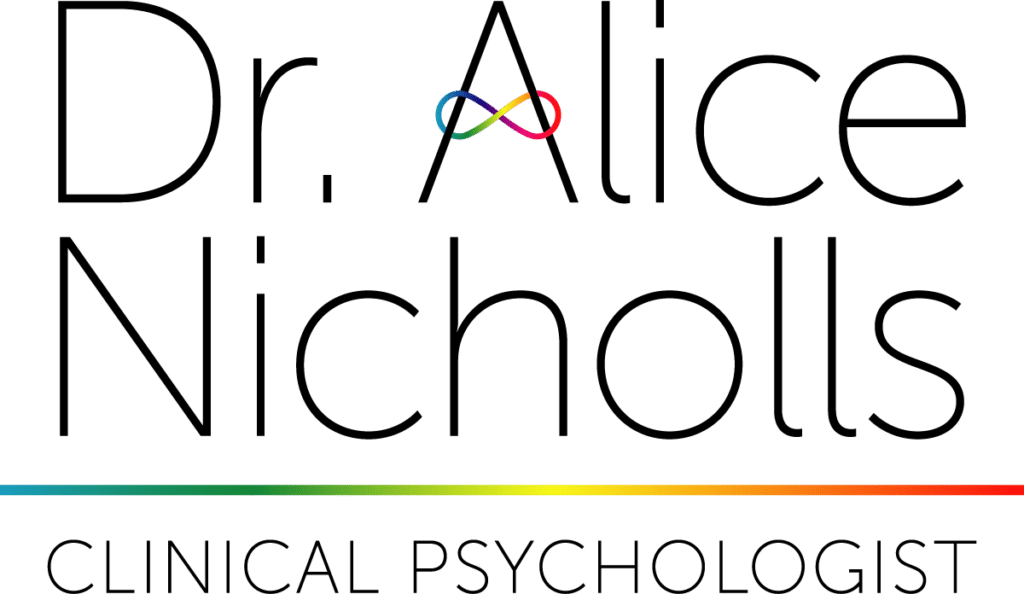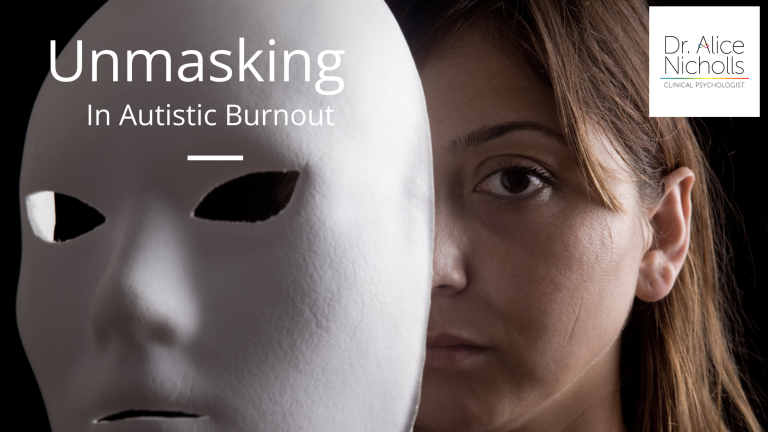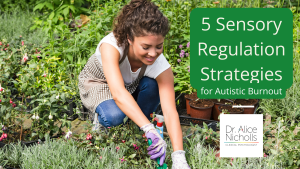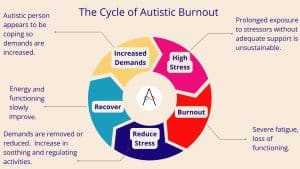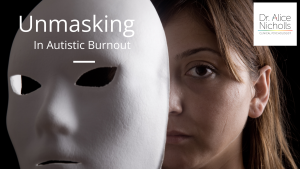Masking is changing the way we look or behave to fit in. Everyone does it to some extent.
But for Autistic people there is more to it.
As Autistic People, living in a predominantly neurotypical society we have been taught to hide our autistic traits and to mimic neurotypical ones. This may have been through formal training programmes such as Applied Behaviour Analysis or it may have been far less explicit.
In this article I will:
- Define what masking is
- Explore why we mask
- Discuss the costs of masking and it’s relationship with Autistic Burnout
- Give you some ideas of how and with whom you might try masking less
- Give you some other ideas of how you might meet your need for connection
What is Masking?
“Masking is a term used by the autistic community to describe the suppression of aspects of self and identity to “fly under the radar” or “appear normal, using conscious (i.e., mimicking facial expressions) or unconscious (i.e., unintentionally suppressing aspects of one’s identity) means” (Miller Rees & Pearson 2021)
The text above is a quote from a paper on Masking in autistic people by Miller Rees and Pearson in 2021.
Here they, and I, are using to the term Masking to include camouflaging and compensations strategies too.
I think the key point in this definition is that the Autistic person who is masking is trying to appear ‘neurotypical’ or at least not stand out as different from neurotypical people.
Another key point (which I will come back to) is, that this can be conscious or unconscious. So you might not even notice you are doing it. Particularly if you have been doing It for a long time.
“Putting on my best ‘normal'”(Hull et al 2017 participant)
“I’m hiding behind what I want people to see” (Hull et al 2017)
“Masking is the language of NTS, it’s not a direct language but an automatic one that autistics have to learn, it takes years and even then there is no perfection to it” (Miller et al 2021 Participant)
Masking can mean lots of things to autistic people, it can include supressing stimulation seeking or soothing behaviours in certain situations, or hiding them. Sometimes we find ways to stimulation seek or soothe in ways that are more socially acceptable.
Some people report feeling like they actually play the part of an entirely different person. So it’s no surprise that many actors are actually Autistic. Sometimes we hide or minimise our response to over stimulation or difficult sensory input. We often have to make a conscious effort to put on the ‘right’ facial expression or tone of voice.
You might find you are monitoring how much eye contact you make and forcing yourself either to make eye contact or using strategies such as looking between the persons eyes. Similarly you might be monitoring how you are holding your body, what you are doing with your hands and legs so that you fit in with other people.
You could be keeping track of how much time you have spoken for, whether it is appropriate or not and making a conscious effort to engage in ‘turn taking’. You might reherse conversations or interactions before they occur, thinking of questions to ask in advance.
Some people develop a set of rules for interacting with others, such as always asking the other person a question after they have been speaking for more than two minutes or trying not to speak unless asked a question. You might take on a role within a group, such as the tea maker or the listener or the party animal(!)
You might avoid talking about things you are interested in if you feel they are out side of the norm or if you feel that once you get started you won’t stop. You might wear clothing you don’t like or isn’t comfortable so that you fit in and you might pretend to like other things in order to fit in.
To summarise, different Autistic people have different experiences of masking. Masking can include:
- Supressing Stims
- Hiding stims
- Using more socially acceptable stims
- Playing a ‘role’ in a situation
- Hiding or minimising response to overstimulation or difficult sensory input
- Making an effort to make the ‘right’ facial expressions
- Forcing self to monitor, make and/or maintain eye contact ,
- Monitoring and adjusting body language to ‘fit in’
- Keeping track of how much time we have spoken for, monitoring we are not talking too much, making a concious effort to engage in ‘turn taking’
- Planing questions to ask the other person and how to have the conversation in advance
- Developing rules for conversations or group settings
- Avoiding talking about interests for fear of talking too much, or being considered odd.
- Wearing uncomfortable clothing to ‘fit in’
- Pretending to like things we don’t
If you are interested in gauging how much you mask you can complete the Camouflaging Autistic Traits Questionaire.
Why Do we Mask?
Masking starts off as an adaptive behaviour, and sometimes it remains so. There is a real risk that we will be discriminated against. It isn’t always safe to unmask. It can also be so well practiced or conditioned that we can’t remove the mask even when we try!
Often we have had experiences of being perceived as different and that leading to our being excluded from friendships, groups or organisations. Sometimes we have had experiences of being interpreted as uninterested, unempatheic, uncaring, aloof or arrogant and we are fearful of this happening again.
Sometimes masking is necessary to work with colleagues successfully and to secure and maintain employment.
Often we’ve had experiences of bullying and harassment and are scared into masking.
And of course sometimes we have been trained to mask. ABA therapy is common, particularly in the US as a ‘treatment‘ for autism, where they try and get the person to behave less autistically by denying them things they like unless they stop stimming, start talking, make eye contact etc.
For alot of us, who weren’t diagnosed as Autistic as children we may well have still been trained out of behaviour that others found odd. Told off for stimming, or told we were making social errors and that people wouldn’t like us if we didn’t behave in a certain way.
We might have noticed neurotypical children getting more positive feedback from other children and adults and tried to mimic them in order to gain the same positive attention.
And of course, all of this learning becomes internalised as shame and self-cricism (I’m not good enough, people don’t like me, etc).
To summarise, here are some of the reasons Autistic people mask:
- Risk of being discriminated against
- Fear of being perceived as different and excluded
- Fear of being interpreted as uninterested, unempathic, uncaring, aloof or arrogant
- To make and maintain friendships and relationships
- To work with colleagues
- To secure and maintain employment
- To avoid bullying or harrassment
- Training-explicitly (e.g. ABA therapy or being told off) or implicitly (noticing others don’t respond well to us, don’t like us, think we’re odd etc)
- Shame and self-criticism
What’s the Problem with Masking?
It should already be clear that masking is a complex issue with some significant costs to you, the Autistic person. It takes significant energy to mask. This means it makes social interactions even more demanding than they would be otherwise. The research on Autistic Burnout is consistently pointing to Masking as a source of stress contributing to Autistic Burnout.
You are probably aware that in situations where you are monitoring your facial expression, trying not to talk too much or too little, or about the wrong things that your ability to process information is reduced. This is because you are already paying attention to so much information, monitoring yourself and cross referencing social rules. There is little cognitive capacity left for anything else.
Masking has been linked with low self esteem and shame. that is, people who feel they would not be accepted for who they are start to internalise these beliefs as shame. Autistic people report feeling inauthentic or fake in their interactions.
There is a growing body of research evidence that masking is associated with poor mental health outcomes in general for Autistic Adults. A recent study (Cassidy et al., 2020) found a relationship between high scores on the CAT-Q with high scores on a measure of ‘thwarted belongingness‘. Thwarted belongingness is a concept based on the theory that all humans need to feel a sense of belonging. When this is absent there is an increased risk of suicide.
What can we do about it?
So what can we do about it?
- Stay Safe
- Identify your safest people
- Start Small
- Increase your experience of connection
Stay Safe
We need a society that values every single person for who they are. We need Autism to be recognised as a Neurotype rather than as a disorder, that comes with its own strengths and challenges. We need Neurodiversity to be celebrated and we need people’s support needs to be met.
As the world currently is, it’s not always safe for us to unmask.
Sometimes we have learned or been trained to mask to such an extent that even starting to consider unmasking causes us huge anxiety. Unmasking can re-activate or uncover shame and self criticism So, if you decide you want to be less masked, it’s really important to look after yourself while you are doing this.
Identify your Safest Person/People
Being less masked with safe people can help you to show up more authentically in your close relationships and this can be incredibly rewarding.
Think of the person you feel the most accepted and safest with in your life. Do you mask with them at all? How do you think they would react to you being less masked? How might you be less masked with them?
Start Small
You might allow yourself to stim more, stop monitoring your facial expression so much or at all. You might start taking what people say at face value rather than trying to interpret their meaning.
You might stop forcing or faking eye contact.
It might be that you don’t usually let people know what you think or how you really feel about a situation and you could start doing more of this.
If you would benefit from using aides such as headphones or tinted glasses but you usually don’t for fear of standing out, you might start to use them more. You might stop wearing uncomfortable clothings or makeup. You might start telling people what you need in a situation where previously you didn’t.
You might allow yourself to talk about or show your emotions, thoughts and interests, even if others might find them strange. You could also start asking for clarification, plans or information, where you would have previously not dared for fear of seeming odd.
Increase Connection
Being less masked with someone you are close to is likely to enhance the relationship and give you a greater sense of connection. It might be worth using this as an opportunity to think about how you want to connect with this person, what you actually enjoy about being around them and what you really want to do when you are with them.
If masking less with key people in your life feels like too much of a stretch at the moment, consider trying to gain that sense of connection in another way.
We often find ourselves accidentally applying neurotypical standards to our experiences of connection.
Research is showing that Autistic people can experience a great sense of community by connecting with other autistic people. Some of us also seem to experience a deep sense of connection with nature, animals, music and art.
Sometimes we find our connection needs are met through working towards an important cause or project alongside other people. We can also find amazing communities of people with the same interests as us, where we can connect over that interest without the need for much talk about anything else. Sometimes connecting online is just as valuable, or more valuable, than connecting in person.
Think about how you might start to move towards animals, things, places, people and activities that would enable you to show up and be appreciated as your more authentic, less masked, Autistic self.
Please take good care of yourself.
If you would like to explore this topic and how it applies to you, you might like my short course on Masking Less and Connecting More with Close Friends and Family.
References:
